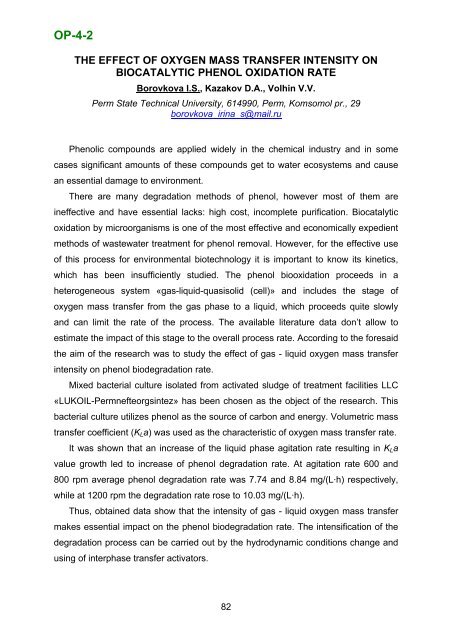Boreskov Institute of Catalysis SB RAS, Novosibirsk, Russia
Boreskov Institute of Catalysis SB RAS, Novosibirsk, Russia
Boreskov Institute of Catalysis SB RAS, Novosibirsk, Russia
- No tags were found...
You also want an ePaper? Increase the reach of your titles
YUMPU automatically turns print PDFs into web optimized ePapers that Google loves.
OP-4-2THE EFFECT OF OXYGEN MASS TRANSFER INTENSITY ONBIOCATALYTIC PHENOL OXIDATION RATEBorovkova I.S., Kazakov D.A., Volhin V.V.Perm State Technical University, 614990, Perm, Komsomol pr., 29borovkova_irina_s@mail.ruPhenolic compounds are applied widely in the chemical industry and in somecases significant amounts <strong>of</strong> these compounds get to water ecosystems and causean essential damage to environment.There are many degradation methods <strong>of</strong> phenol, however most <strong>of</strong> them areineffective and have essential lacks: high cost, incomplete purification. Biocatalyticoxidation by microorganisms is one <strong>of</strong> the most effective and economically expedientmethods <strong>of</strong> wastewater treatment for phenol removal. However, for the effective use<strong>of</strong> this process for environmental biotechnology it is important to know its kinetics,which has been insufficiently studied. The phenol biooxidation proceeds in aheterogeneous system «gas-liquid-quasisolid (cell)» and includes the stage <strong>of</strong>oxygen mass transfer from the gas phase to a liquid, which proceeds quite slowlyand can limit the rate <strong>of</strong> the process. The available literature data don’t allow toestimate the impact <strong>of</strong> this stage to the overall process rate. According to the foresaidthe aim <strong>of</strong> the research was to study the effect <strong>of</strong> gas - liquid oxygen mass transferintensity on phenol biodegradation rate.Mixed bacterial culture isolated from activated sludge <strong>of</strong> treatment facilities LLC«LUKOIL-Permnefteorgsintez» has been chosen as the object <strong>of</strong> the research. Thisbacterial culture utilizes phenol as the source <strong>of</strong> carbon and energy. Volumetric masstransfer coefficient (K L a) was used as the characteristic <strong>of</strong> oxygen mass transfer rate.It was shown that an increase <strong>of</strong> the liquid phase agitation rate resulting in K L avalue growth led to increase <strong>of</strong> phenol degradation rate. At agitation rate 600 and800 rpm average phenol degradation rate was 7.74 and 8.84 mg/(L·h) respectively,while at 1200 rpm the degradation rate rose to 10.03 mg/(L·h).Thus, obtained data show that the intensity <strong>of</strong> gas - liquid oxygen mass transfermakes essential impact on the phenol biodegradation rate. The intensification <strong>of</strong> thedegradation process can be carried out by the hydrodynamic conditions change andusing <strong>of</strong> interphase transfer activators.82
















